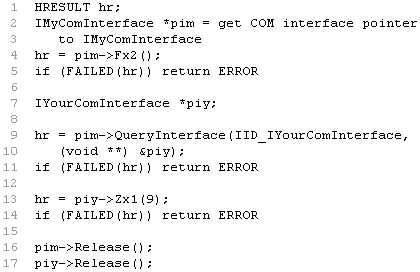| Lesson 13 | The client's view of IUnknown |
| Objective | Explain how the client views IUnknown. |
Client's View of IUnknown

| Line 1: | The declaration of an HRESULT. This is used to hold the return value of COM calls. |
| Lines 2 and 3: | Here MyComObject is initialized and we get an interface pointer to interface IMyComObject. We will cover the details of how this is done in the next module. |
| Line 4: | A call is made to IMyComInterface::Fx2. |
| Line 5: | A check is made on the return value from Fx2. FAILED is a standard COM error checking macro. |
| Lines 7: | This declares a variable as a pointer to COM interface IYourComInterface. |
| Lines 9 and 10: | IMyComInterface::QueryInterface is called to get a pointer to IYourComInterface. |
| Line 13: | If the QueryInterface call is successful, this calls IYourComInterface::Zx1. |
| Line 14: | The FAILED macro is used to check the status of the previous COM call. |
| Line 16: | This calls IMyComInterface::Release. |
| Line 17: | This calls IYourComInterface::Release. Interface pointers held by a client should be considered invalid after calling Release. |
Reference Counting - Exercise
Click the Exercise link below to apply what you have learned about reference counting.
Reference Counting - Exercise
Reference Counting - Exercise